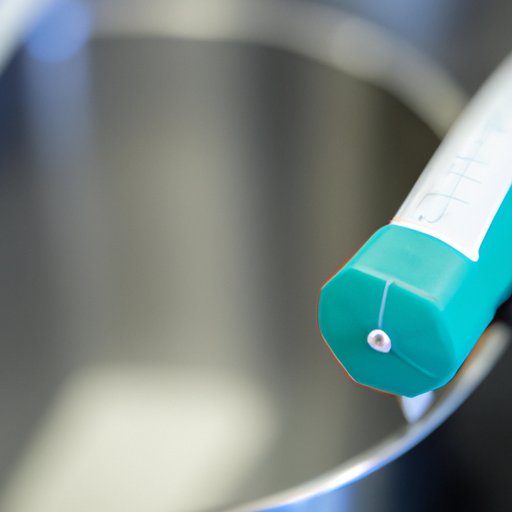
Introduction
Measuring volume accurately is an essential skill in various settings, including science experiments, cooking and baking, and industries like pharmaceuticals and mining. Even in everyday life, accurate volume measurement can make a big difference. This beginner’s guide will cover the basics of measuring volume, common tools used for volume measurement, and tips and tricks for achieving accurate measurements.
A Beginner’s Guide to Measuring Volume: Understanding the Basics
Volume is the amount of space an object takes up, and it is usually measured in liters, milliliters, gallons, cubic inches, or other units depending on the context and location. For instance, liters and milliliters are commonly used to measure the volume of liquid in scientific experiments, while cubic inches are used for measuring the volume of solids or small items that can fit in a container. Common tools for measuring volume include beakers, graduated cylinders, burettes, pipettes, and simple measuring cups and spoons.
Measuring volume accurately is often essential in everyday life. For example, when cooking or baking, precise measurements of ingredients like sugar, salt, and flour can be the difference between a dry, flat cake and a deliciously moist one. In addition, with the current pandemic situation, people are required to follow recipes and bake at home, making measuring volume even more important.
Measuring Volume for Cooking and Baking: Tips and Tricks
When measuring liquid volume in the kitchen, the most common tools are measuring cups and spoons. However, it is important to note that the same measuring cup may not always be used for liquids and dry ingredients. Liquid measuring cups usually have a spout and are clear to make the measurement process easier. On the other hand, dry measuring cups are usually made of metal or plastic and have a flat surface to level off the ingredient.
To achieve accurate measurements, it is important to follow the recipe and level off dry ingredients with a flat surface. Similarly, when measuring liquids, it is necessary to pour the liquid into the measuring cup cautiously and at eye level. Spillage and imprecise measurements can affect the overall taste and texture of the dish. With a little bit of practice and attention to detail, anyone can become proficient in measuring volume for cooking and baking.
5 Ways to Measure Volume for Science Experiments
In science experiments, different types of equipment are used for measuring volume depending on the purpose and substance. Burettes are commonly used for titrations to avoid missing the desired amount of liquid. Pipettes are commonly used to measure small volumes of liquids precisely. Graduated cylinders provide a better approximation of the volume of liquids. In addition, vibrating sample magnets or Archimedes’ principle can be used in solid samples to measure their volume.
To measure volumes effectively in science experiments, the most important factor is cleanliness and accuracy. Contamination or an inaccurate measurement can affect the final result and render the experiment pointless. Therefore, any used laboratory equipment must be clean and dry before being used to avoid contamination of the solutions.
How to Measure Liquid Volume Using Displacement
When it comes to measuring the volume of irregularly-shaped containers, liquid displacement techniques can be used. This technique involves filling a graduated cylinder with water and carefully placing the object to be measured in the cylinder. The amount of water displaced by the object reflects its volume. This technique is also useful for measuring the volume of objects that float.
To measure liquid volume using displacement, fill the graduated cylinder with water and record its volume. Carefully lower the object or substance you would like to measure into the cylinder and note the new volume. The difference between the initial and final volume reading is equal to the volume of the substance or object you are measuring.
The Importance of Accurate Volume Measurement: Applications in Industry and Research
Accurate volume measurement is essential in industries such as pharmaceuticals, mining, and oil and gas, where the smallest imprecision can have dire consequences. In pharmaceuticals, for example, inaccurate volume measurements can lead to improper dosages or even harm to patients. Inaccurate volume measurement in mining can lead to environmental damage or economic losses. In addition, in research, the potential loss of data could lead to irreparable harm.
Therefore, the importance of accurate volume measurement in research and industry cannot be overstated. In every industry, attention to detail in measuring volume is critical to ensuring the highest quality standards are met.
Conclusion
Measuring volume accurately is an essential skill in various settings. Whether you are baking, conducting science experiments, or working in a particular industry, it is vital to pay attention to detail and use the right tools to achieve accurate measurements. This beginner’s guide has covered the basics of volume measurement, common tools used, and tips for achieving accurate measurements in the kitchen and laboratory. We hope that this article has been helpful, and we wish you all the best in your future volume measuring endeavors.





